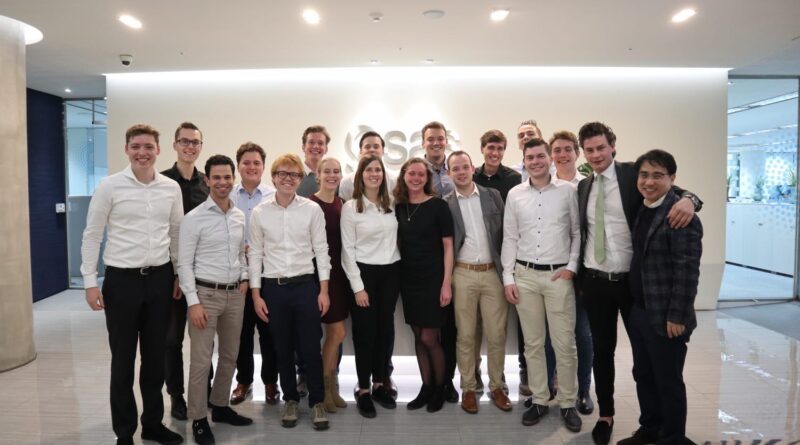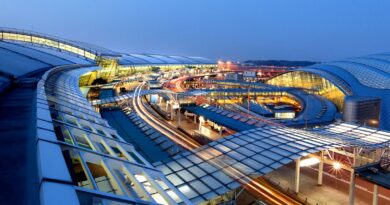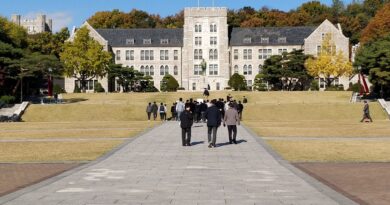Econometricians explore Seoul
On the early morning of Monday October 22, 21 Asset | Econometrics members and I flocked to Schiphol Airport. The day marked the first day of the Asset | Econometrics International Business Tour (IBT). Most of us started the IBT how we would end it; having slept about half of the recommended eight hours, keen to rest our eyes on the long haul from Warsaw, where we would be having an overlay, on our way to Seoul, the destination of this year’s IBT. The booklet the committee had put together informed us that the title for the first day was “Poolse taferelen”, which loosely translates to “dramatic scenes in Poland”. And boy did we have some Poolse taferelen: while waiting at the gate in Warsaw, now all basically asleep, our flight got cancelled.
Written by: Hans de Ferrante
Luckily, our airline of choice, LOT (with only coincidentally the cheapest flights) handled the situation with great care, and was able to quickly place seven of us, myself included, on flights scheduled to Seoul with a layover in Moscow. Shortly after, Jasper and Dion were informed they would travel together via Doha, Qatar. Their delight in this romantic getaway did not last long, as all other participants were also assigned a seat on this flight. Relief set in at the realization we would all make it to Seoul on the scheduled day of arrival. Little did we know that the Moscow flight would be delayed, and seven of us – myself included – would stay the night in Warsaw. Despite this hassle, we decided to make the best out of our time in Warsaw, with the highlights being feasting on the hotel’s delicious carpaccio buffet and Arike sleeping through our loud games in a bar in downtown Warsaw.
The next day the seven of us were luckier reaching Seoul, where we quickly headed to the Dutch embassy. There, we rejoined our Qatari friends and Bas, the IBT fossile who saw chance to fly in from his research fellowship in St. Petersburg. They had spent the morning visiting SAS, the American analytical software company and main sponsor of the IBT. At the Dutch embassy, we were given a presentation about Korea, which provided us with a bird’s-eye view of the country we were visiting. Among others, we got to know about the popularity of plastic surgery, Korea’s big conglomerates, their perceptions of the Dutch, and the fast economic growth that characterized the country after the Korean War.
We also briefly spoke about Korea’s politics, which we assumed to be a current topic in light of former President Park’s 25 year jail time. She was jailed for leaking state secrets and siphoning off funds to Choi Soon-sil, her close friend and daughter of a shamanist cult leader who is jokingly referred to as the Korean Rasputin. At the embassy we learned this episode was not too extraordinary, as being president is a good predictor for future jail time. That in Korean politics some more peculiarities are involved, became clear during a later visit to the National Assembly, Korea’s national parliament, where we were told Korea’s assembly members had only exchanged physical fights for verbal disputes some ten years prior.
One point that particularly stood out at the embassy is how serious Koreans are about education; young Koreans have the highest level of tertiary schooling among OECD countries. This fixation on education starts early: it is not uncommon for Korean parents to shell out hundreds of US dollars on private tutoring, or to send their children to Chinese school to acquaint them with the Western counting system. The end goal of this spending is a great score at Suneung, the central college entrance exam. Suneung day is not only a serious matter for students and their parents: on the exam day airplanes are not allowed to take off during the English language listening section and businesses are open late en masse to prevent traffic jams. Even as few as two mistakes on this full-day test can preclude entry to Korea’s top 3 universities.
For the IBT, visits were scheduled to two of these universities. We first visited Yonsei University, located near the bustling student area of Hongdae, where we were guided over the stunning campus by two Korean students. They were noticeably trained for the matter, with an almost suspicious thoughtfulness. For instance, they saw fit to do the walking tour backwards so that we would not miss a moment to fire questions at them, and asked more than a dozen times whether people in the back could hear them. A visit to the second university near the end of our trip, Korea University, started with a similarly stiff campus tour. With large open spaces and beautiful buildings, the campus was reminiscent of Yonsei’s, although there were some notable differences: where Yonsei was adorned with navy blue banners and images of eagles were scattered across its campus, Korea University was engulfed in crimson red and images of tigers. Vaguely familiar was Korea University’s slogan, “Libertas, Iustitia, Veritas”. Our guides, Kelly and Jennifer, did not have a translation when asked for one. They were quick to point out, however, that it came from Harvard, as did the crimson red; Yonsei’s navy blue was Yale’s.
Scheduled after the campus tour was a lecture by Prof. Myeon-jae Lee, a Korean professor of econometrics who had spent some time at Tilburg University. He welcomed us and told us about the warm memories he had from his time at Tilburg University, collaborating amongst others with Prof. Arthur van Soest. He lit up in particular speaking about the faculty’s soccer team, with whom they not only beat the students’ team but – to his surprise – also went on to win a national tournament. He continued speaking about difference-in-difference estimation, including some interesting extensions I had not seen in our courses. Somewhat tragicomic to the lecture – but in line with what we had heard at the embassy – is that the center stage example featured plastic surgery as the treatment and “beauty level” as the outcome.
After the lecture, we had lunch with Prof. Lee’s econometrics students. We spoke about life in Korea and life in the Netherlands. It made me realize we have it quite easy, with great job prospects and a lot of free time in comparison to Korea, where the extreme competition takes a real toll on students and job prospects are poor – even for econometrics graduates. After lunch, some of us headed back to the hostel to change into hiking attire – Prof. Lee and his students were astonished with how unsuitable our business casual attire would be for the city hike we had planned together. During the hike itself it became clear why Prof. Lee had won the soccer tournament; the man was an athlete, darting up the mountain leaving us and his students gasping for air.
Besides SAS and universities, we also paid a visit to Blocko, a Korean blockchain startup. There, we were received by an endearingly nervous Korean employee and a German programmer who had extended his stay in Seoul to develop blockchain modules for Blocko. They managed to veer away from most of the buzz surrounding it, and discussed with us the underlying technology rather than empty promises as to how it would revolutionize the world.
We also visited the Samsung Museum of Innovation, for which we traveled to the city of Suwon. Samsung maintains a big presence in this city, which houses its largest R&D center with some 130 buildings and 70.000 employees. Among the products being developed there are the well-known Galaxy Note series. The museum itself consisted of three floors, representing the past, present and future of technology. Especially the future was fun, with a big surprise to us how much we had all desired the companionship of Samsung newest fridge, which was equipped with a personal assistant and cameras that allow you to livestream your food while you’re out of the house.
On the cultural/historical front, we paid a visit to the War Memorial of Korea and its Korean Museum of War. This museum tells the history of the Korean War, which lasted from 1950 until 1953, when an armistice was signed. That Seoul was not left unscathed had already become clear to us during the visit to Yonsei University, whose main buildings still show bullet marks, and our visits to the various Joseon dynasty palaces, which were all rebuilt from scratch. The museum showed us, however, how almost all settlements on the peninsula were destroyed by 1953.
We also made a trip to the Korean border. However, the North and South had begun removing land mines from the fortified border earlier in the week which meant that we could not visit the Joint Security Area (the presumed highlight of any tour to the Korean border). With the rainy weather also blocking any views of North-Korea, leaving us at a vantage point watching images on a television screen: the tour was not the most exciting part of our trip.
Interspersed in the program was ample free time which we used to enjoy Korean food and further explore Seoul. We particularly frequented Korean BBQ restaurants, where meat is served raw and tables are equipped with gas or charcoal stoves. Eating Korean BBQ is somewhat of a ritual, with grilled meat to be wrapped inside a lettuce leave with seasoning and sesame oil, then to be eaten in one bite. As we were completely unaware of this, we became quite the laughing stock at the first restaurant we visited, although the Koreans were eager to explain. By our last night, we had become quite skillful (although the waiters still jumped in to grill the meat for us). BBQ also comes with a number of side dishes, as did virtually all dishes we ordered in Korea. Perhaps the most famous one is kimchi, the fermented cabbage dish. Most of us quickly stopped feigning to care about these. For drinks, we often had beer (“maekju”) with a local rice wine (“soju”), the mix of which makes “SoMaek”.
Spicing up our beers with soju often meant we were more than keen to go out. Fortunately, Seoul also had a lot to offer in that department. Close to our hostel was Zen, a local bar where students would hang out, have drinks, and play games. Most of the group had discovered it early on in the IBT and it quickly became the go-to bar. We also visited three bars and a club with the Seoul Pub Crawl in Itaewon, a district which features many international bars and where many expats live.
Highlight for me was when we celebrated Halloween there, joining Koreans and a Kim Jong Un impersonator dancing on the streets until the late hours. Days we did not make it to a club we often ended up showing off our singing voices at a five-story karaoke place near our hostel, where each room was equipped with four microphones. Bonus was the view they offered over Hongdae, the student area close to our hostel, as the exterior walls of each private karaoke room were made from glass.
A hike in Bukhansan national park provided a welcome antidote to all this overeating and soju abuse. I opted to take the intermediate trail to Baegundae peak, the highest in the park. Others chose the expert trail, whose narrow paths with cliffs on both sides implied they returned with near-death experiences. To the Korean hikers we encountered in the park we must have looked like lost tourists, as virtually all of them were dressed from top-to-bottom in specialized hiking gear – this includes, of course, walking sticks. Especially near the top of Baegundae peak, inclines became very steep, with steel cables and ropes a necessity to prevent sliding from the slippery rocks. The views from the top were rewarding, with great views on both sides of Seoul’s metropolitan area.
Activities I have failed to mention were a cycling tour on Yeouido Island and a city tour through Suwon (including to an eyebrow-raising toilet museum). A recurring theme during these (and other) visits was shrieking at chairs so comfortable falling asleep was all but guaranteed. When we headed back to the Netherlands via beloved Warsaw, it was for me thus with mixed feelings; I longed for some real sleep and was keen to be productive again, but also felt sad the extremely fun trip was over. Key to this fun was of course the extraordinarily enjoyable and laid-back group and the great organization by Claire, Robert, Wenxin, Arike, Max, and Koen.




